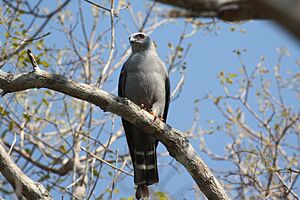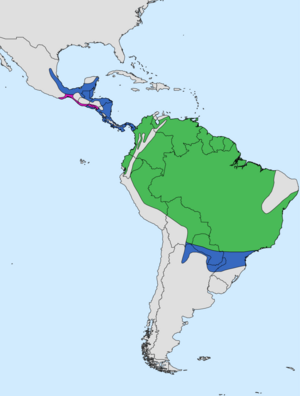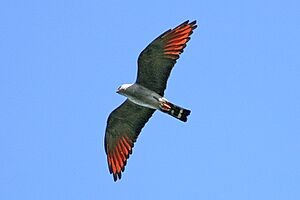Plumbeous kite facts for kids
Quick facts for kids Plumbeous kite |
|
|---|---|
 |
|
| In Mato Grosso do Sul, Brazil | |
| Conservation status | |
| Scientific classification | |
| Genus: |
Ictinia
|
| Species: |
plumbea
|
 |
|
| Blue: Breeding; Green: Year-round; Purple: Migration | |
The plumbeous kite (Ictinia plumbea) is a type of bird of prey, like a hawk or eagle. It belongs to the Accipitridae family. These birds live in many parts of northern South America all year round. Some plumbeous kites travel, or migrate, to places as far north as Mexico. They mostly eat insects, which they catch either from a branch or while flying.
Contents
About the Plumbeous Kite's Name
The plumbeous kite was first officially described in 1788. A German scientist named Johann Friedrich Gmelin gave it its first scientific name. He placed it in the group Falco, which includes falcons.
Later, in 1816, a French scientist named Louis Pierre Vieillot created a new group, or genus, called Ictinia. The plumbeous kite, along with the Mississippi kite, now belongs to this group. The name Ictinia comes from an old Greek word for a kite bird. The word plumbea comes from Latin and means "lead-colored," which describes the bird's gray feathers.
What Does a Plumbeous Kite Look Like?
Plumbeous kites are about 34 to 37.5 centimeters (13 to 15 inches) long. Males weigh between 190 and 267 grams (6.7 to 9.4 ounces). Females are a bit larger, weighing 232 to 280 grams (8.2 to 9.9 ounces). They have long, pointed wings.
Adult plumbeous kites are mostly a dark gray color, like slate. Their head and belly are a lighter gray. Their short black tail has two or three white stripes underneath. They have bright red eyes and orange legs. When they fly, you can see a reddish-brown patch on their main wing feathers.
Young plumbeous kites look a bit different. Their upper parts are gray with white streaks. Their underparts are whitish with dark streaks. They do not have the reddish-brown wing patch that adults have. The plumbeous kite makes a whistling sound that sounds like si-see-oo.
Where Plumbeous Kites Live
Plumbeous kites live in lowland forests and open grasslands called savannahs. They raise their young in a large area called the Neotropical realm. This area stretches from eastern Mexico all the way down to Peru, Bolivia, and Argentina. They also breed on the island of Trinidad.
Some plumbeous kites are migratory. This means they travel to warmer places for part of the year. Birds from the northern and southern parts of their breeding range, including Central America, Trinidad, Venezuela, Colombia, and southern Argentina and Brazil, fly to tropical South America during the northern winter.
Plumbeous Kite Behavior and Habits
Plumbeous kites usually fly alone or in small groups. However, you might see them in larger flocks when they are migrating.
Plumbeous Kite Reproduction and Life Cycle
Plumbeous kites build deep nests made of sticks. They place these nests high up in trees. Sometimes, they even build nests in mangrove swamps, right over the water.
A female plumbeous kite usually lays one egg, but sometimes she lays two. The eggs are white or very light blue. They are about 41 by 35 millimeters (1.6 by 1.4 inches) in size. Both parents take turns sitting on the eggs to keep them warm. This incubation period lasts for 32 to 33 days.
When the chicks hatch, they are covered in soft white down feathers. Both parents feed the young birds. The young kites are ready to fly, or fledge, when they are about one month old.
What Plumbeous Kites Eat
Plumbeous kites are skilled hunters. They catch most of their food, which is insects, either while flying through the air or by swooping down from a perch. Sometimes, they also eat other small animals. These can include snails, frogs, lizards, bats, small birds, and even snakes.



